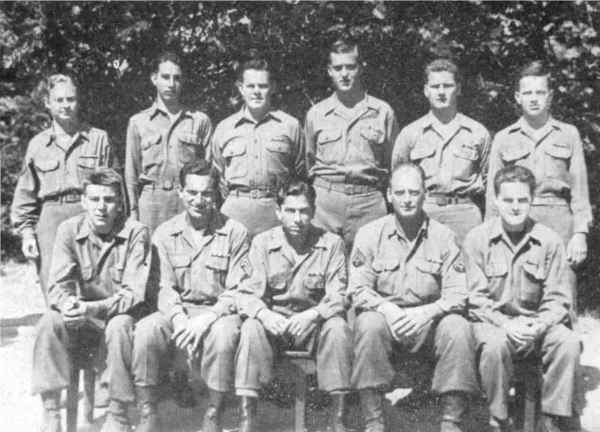Meterological and Survey Sections

Top row: Tec. 5 Moss E. Cassity, Pvt. Russell D. Hughes, Pfc. Paul M. Brewer, Pvt. Robert W. Barnes, Tec. 5 John R. Walker, Pvt. John R. Schaeffer.
Bottom row: Pvt. Donald M. Axtell, Tec. 4 Merwyn Worthman, Tec. 4 Amando R Uresti, Jr., Tec. 5 John M. Jones, Pvt. William O. Johnson.
To make firing data more accurate, two teams, within Division Artillery worked most diligently during our combat period. The Meteorological section is an integral part of the Division Artillery Fire Direction Center. It is charged with the task of supplying weather data necessary for the pin-point direction of artillery fire. The section was formed in England prior to the unit's departure for France. The formation and training of the section was entrusted to the capable hands of Lieutenant William S. Battersby and Sgt. Thomas I. Walker. Their training was applied most effectively under combat conditions. The portable weather station was always present during the five major campaigns to insure the utmost accuracy in artillery fire.
One of the greatest challenges to the artillery of a spearheading armored division is to provide survey control. This was particularly true in the drive across Brest where the 6th Armored Division Artillery, due to the speed and tactical changes of that maneuver, often found themselves operating beyond the areas covered by available maps. Without adequate maps for accurate firing data, the artillery was consequently faced with the possibility of being reduced to direct fire weapons, and the massing of fires, which at times were direly needed for flank security, rendered impractical if not impossible. This situation was alleviated if not entirely solved by Lt. Battersby, "whip and guiding hand" of the survey crew. Pulling three point resections, coordinates, short-cut methods of traversing great distances, solar or polaris azimuths (and even orienting lines), out of thin air were some of the demands mad of the survey section. The section also served as reconnaissance personnel, augmented battalion crews on O. P.'s, and at times served as liaison personnel. Although theirs was, indeed, a highly technical and difficult job, and at times one that was almost impossible to perform, they did it with an effectiveness which earned the respect and admiration of the units they serviced.
At Bastogne alone despite the fact that intense cold froze the instruments periodically, this crew went on to supply information to an observation battalion and eighteen field artillery battalions. The 324 guns thus linked fired a total of 101,244 rounds in a nineteen day period to repulse the repeated counterattacks and whip the cream of the German army.
The high efficiency and accuracy of their work which never lessened even under the most adverse and hazardous conditions is a tribute to the technical ability and courage of such men as Sergeants Souza, Uresti, and Worthman, Corporals Cassity and Jones, and Privates first class Van Bramer, Brewer and Johnson.
These are two teams who helped put the batting average of Division Artillery at the top of the best of "big leaguers."
NOTE: Remove question mark from address below when sending email
This page is maintained by Bruce Frederick, EMAIL .
Last updated: March 2, 2002
